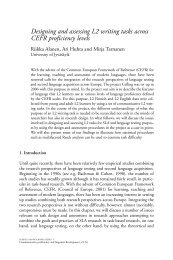BOOK OF ABSTRACTS - EUROSLA
BOOK OF ABSTRACTS - EUROSLA
BOOK OF ABSTRACTS - EUROSLA
You also want an ePaper? Increase the reach of your titles
YUMPU automatically turns print PDFs into web optimized ePapers that Google loves.
quality of some of their vowels converges – they become more like each<br />
other - suggesting that they have developed an accent which is, at least as far<br />
as vowel quality is concerned, a characteristic of the group. The phonetic<br />
features shared by the group members are considered in relation to the<br />
phonetic features of their own pronunciation of their L1, Swedish, and to<br />
those of GA and RP, two varieties to which the students have been<br />
extensively exposed. However, most of the English the students are exposed<br />
to is produced by their peers. It has been documented that learners who share<br />
an L1 are likely to influence each other in their pronunciation (e.g. Jenkins<br />
2002) and the notion of the importance of pronunciation for group identity<br />
lies behind much classic and current sociolinguistic research. This study is a<br />
description of some of the changes that these speakers make in their<br />
pronunciation as they become a speech community in their second language,<br />
English.<br />
Jenkins, Jennifer, (2002). A sociolinguistically based, empirically researched<br />
pronunciation syllabus for English as an International Language. Applied<br />
Linguistics (2002) 23 (1): 83-103.<br />
Accuracy and complexity in second language speech: Do specific<br />
measures make the difference?<br />
Nel de Jong 1 and Petra Poelmans 2<br />
1 2<br />
Free University Amsterdam, Fontys University of Applied Sciences<br />
This talk reports on a new analysis of data from a previous study (De Jong &<br />
Vercellotti, 2011). In that study we examined the fluency, accuracy, and<br />
complexity of second language speech elicited by five picture story prompts<br />
with similar narrative structure and storyline complexity in order to obtain<br />
normative data for future studies. Participants were 23 high-intermediate<br />
ESL speakers with various language backgrounds (n=25; age M = 25.8<br />
years). Unexpectedly, we observed differences between the prompts in terms<br />
of fluency but not accuracy and complexity. The fluency differences might<br />
be explained by the greater inference required to understand some of the<br />
transitions between the pictures. Therefore, it is likely that there should be<br />
differences between the stories in terms of accuracy and especially<br />
complexity as well. The fact that no differences were found may have been<br />
due to the global nature of the measures: error-free clauses, error-free AS<br />
units, clauses per AS unit, and words per AS unit (cf. Robinson et al., 2009).<br />
The present study addresses two questions. First, do more specific<br />
measures of accuracy and complexity reveal differences between stories?<br />
Second, do the group data overshadow individual differences: although there<br />
might not be significant overall differences between prompts, there could be<br />
differences at the level of the individual speaker. To answer these questions,<br />
we analyzed more specific measures of accuracy and complexity that were<br />
15



